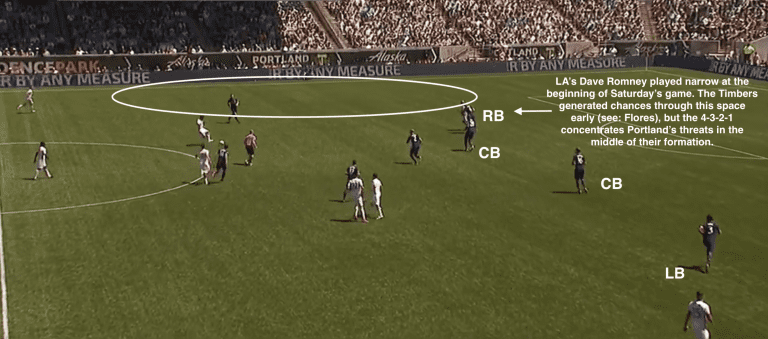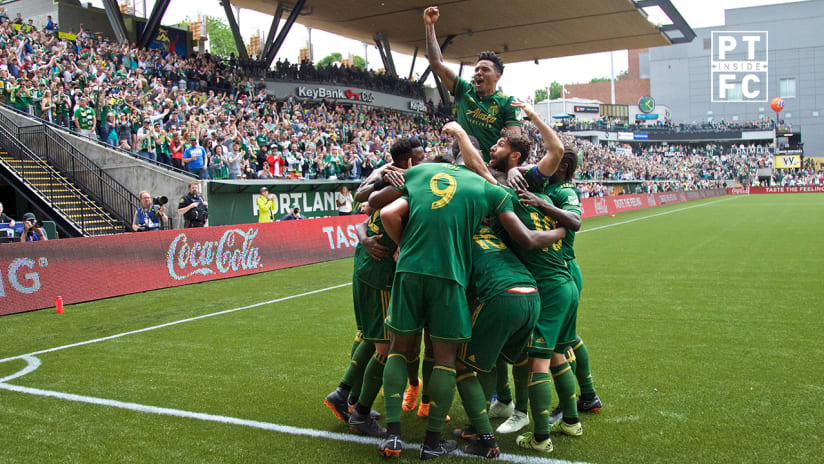“It was hard, because we created so many opportunities in the first half.”
Diego Chara’s reaction to Saturday’s game echoed his coach’s. Giovanni Savarese conceded his team had good chances, as did Sebastián Blanco, who described the team as “angry” they didn’t convert. Had you surveyed the entire Timbers locker room after Portland’s 1-1, Saturday draw with the LA Galaxy, you would have been unlikely to find anybody bemoaning the team’s lack of chances. They were there, especially in the first half. It was just a matter of doing more.
Take this early opportunity for Andrés Flores, …
… or the one that followed for Chara, …
… and where does this Bill Tuiloma shot end up without the instincts of Michael Ciani?
For most teams in Major League Soccer, this is just a typical match day. They may call the NBA a make-or-miss league, but the same could be said for professional soccer, not just in MLS but across the globe. Convert on your chances, and do so at a rate that’s better than average, and you’re probably taking full points. Fail, and you’re left ruing the nature of the sport.
The Timbers’ ruing, however, takes on another dimension when you consider three things, factors that seem to define their potential predicament:
- Last season, the Timbers seemed to disproportionately rely on two goalscorers, Diego Valeri and Fanendo Adi, and were severely hampered when the latter got hurt;
- This year, the team is getting goalscoring from three positions (striker, and its two attacking midfielders) but have yet to craft a consistent threat from their formation’s eight deeper players;
- Opponents’ use of three central defenders (or, formations that emulate this) may make creating threats from beyond the team’s three most-central attackers all the more important.
Spoiler, we’re going to walk through all three of those facets, below, but notice I use phrase “potential predicament.” With the Timbers averaging 1.9 goals per game since switching to their 4-3-2-1 formation, the evidence argues against worrying too much. The attack, it seems, is fine. After all, only six teams in MLS have a better scoring rate than that.
But with the team coming off a stretch of six straight wins – a stretch that’s highly unlikely to be replicated again this season – it’s logical to look for places where Portland might regress to a lower mean. And if teams can truly start to slow whatever three-pronged attack Savarese chooses, the ability for others to step up could become a defining part of the 2018 season.
El Pasado: Where the goal-scoring was
Throughout the season, this space has harped on how much things have changed since last November. New coach, new staff, new style, new players. How much from the past can we draw on to predict the future?
When it comes to pure goal-scoring, though, the past might be the best we’ve got, particularly since the same people scoring goals last year are the ones finding the scoresheet this season, even if the Timbers have diversified their approach slightly under Savarese. This year an additional starter is consistently contributing goals.
2017 Leaders |
G/90 min |
2018 Leaders |
G/90 |
|---|---|---|---|
Diego Valeri |
0.63 |
Samuel Armenteros |
0.71 |
Fanendo Adi |
0.48 |
Diego Valeri |
0.51 |
Darren Mattocks |
0.31 |
Sebastián Blanco |
0.43 |
If Blanco’s 2018 scoring rate is any indication (a huge caveat, since his 1,051 minutes this season is still a relatively small sample), this year’s team has solved one of its inherited problems, with last campaign having been undermined by Adi’s late-season injury. But with so many goals concentrated in two players’ boots, the Timbers needed to find another option, if for no other reason than it left the team vulnerable to fitness instead of form.
| Team | Goals | Pct. from Top 2 |
|---|---|---|
| Chicago Fire | 61 | 62 |
| Columbus Crew | 53 | 62 |
| New York Red Bulls | 53 | 62 |
| New York City FC | 56 | 54 |
| Portland Timbers | 60 | 51 |
| FC Dallas | 48 | 48 |
| Minnesota United | 47 | 47 |
| Orlando City | 39 | 46 |
| San Jose Earthquakes | 39 | 46 |
| Philadelphia Union | 50 | 46 |
El Presente: Three prongs instead of two
Fast forward to this year, and if Adi goes down, the team has Samuel Armenteros. If Armenteros goes down, there’s the Valeri-Blanco tandem, who can both score goals. Only then, if one of those attackers falls, will 2017’s problems resurface, but really, if any team loses three of their top four scoring options, they’re probably up a fetid creek without a much-needed tool.
Still, any coach wants his attack to be constantly improving. As Savarese said on Saturday, he’s never satisfied with his team’s chance creation, even when they have enough to take full points. But the fact that the Timbers, with their current formations, have no way to play all four of their scorers at once adds a little urgency to the problem. As of now, the sources of Portland’s attacking options are, in a way, polarized, with Savarese’s team divided into players with some scoring history and others with, functionally, none.
| Team | Games | Goals | Pct. from Top 4 |
|---|---|---|---|
| Colorado Rapids | 12 | 14 | 100 |
| Montreal Impact | 14 | 15 | 87 |
| Seattle Sounders | 11 | 7 | 86 |
| New England Revolution | 14 | 24 | 83 |
| Chicago Fire | 14 | 20 | 80 |
| Portland Timbers | 12 | 20 | 80 |
| New York City FC | 14 | 29 | 79 |
| D.C. United | 10 | 14 | 78 |
| LA Galaxy | 14 | 19 | 74 |
| San Jose Earthquakes | 13 | 19 | 74 |
Above, among the teams most reliant on their top-four scorers thus far this season, you have a collection of good attacks and bad. But for the most part, you have a collection of teams that are struggling in the standings. New York City FC and the Timbers are the only two teams that are above fifth in their conferences in points per game.
I don’t think coaches, generally, think of their scoring problems in this way, though. Of course, they’re worried about who can and can’t score goals, but generally, that comes down to the quality of chances players and their teammates generate. If we create good chances, coaches typically think, the goals will come. So, when the Timbers put a player like Flores in on goal in the fourth minute, there’s less worry about who the chance fell to and more satisfaction that the chance was created at all.
Take the Timbers’ 2013 campaign, for example. In Caleb Porter’s first season in Portland, the team had five different players score at least seven goals, but would anybody look at the MLS histories of Will Johnson, Darlington Nagbe and Rodney Wallace and say, “oh, we can definitely count on him for goals?” I’m sure somebody would, but their profile picture’s probably an egg, and their user name may be “@RC2013TID.” That year’s Timbers were creating chances for all, just like last year’s team was creating chances for few.
El Futuro: The way they’re setting up
That’s why the three-center-back defense so many opponents are using could yet loom large. We’ve harped on it before, but it really does matter. All of the Timbers’ main goal-scoring threats operate through the middle. None of Adi, Armenteros, Blanco or Valeri are going to make their living going wide, beating a man, cutting in to destroy worlds. Gareth Bale, these guys are not. So, when teams start three center backs and crowd the middle – or, as the Galaxy did this weekend, keep one fullback so tight that the defense is functionally a three-man middle – the Timbers may have to come up with a fourth option.

And, to a certain extent, they have. This weekend was a great example. Are those chances going to be missed every weekend? Probably not. The question is whether enough of them go in to make 2018 like the ubuntu, everybody gets some 2013, or will this year’s team end up being just a slightly more egalitarian version of 2017.
Important to note: Both of those teams finished atop the Western Conference. Whether this year’s team can find a fourth goal scorer won’t lock-it-in determine the team’s fate. Instead, it will merely define this year’s attacking challenges.
If Goal Scorer No. 4 (which, as of now, is a proper noun in this space) can come off the milk carton and step onto the field, the Timbers have a clear route to being an elite team come the end of this Major League Soccer season. If not, they may need to come up with another solution, one that will likely involve more ways to get Adi, Armenteros, Blanco and Valeri on the scoresheet.












